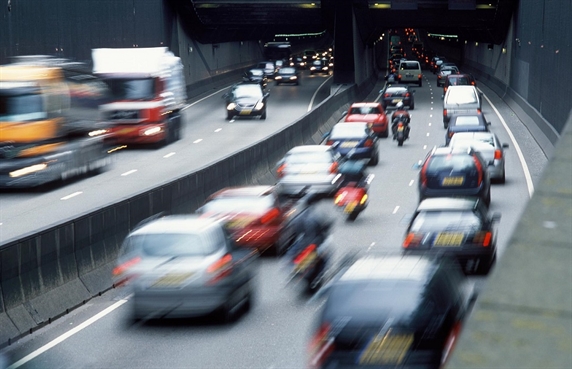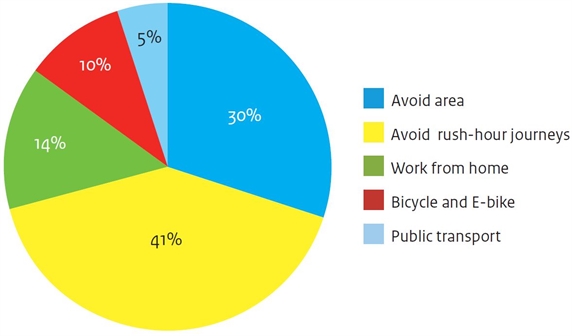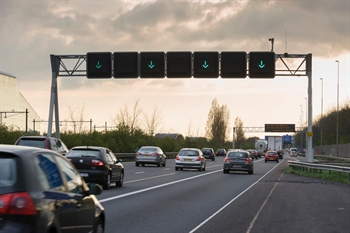Fact sheet Rush-hour avoidance projects
The projects can be used as a measure to reduce disruption during major road works (more about this can be found in the case study Galecopper Bridge Rush-hour avoidance). Rush-hour avoidance projects can also provide a solution for the alleviation of structural congestion bottlenecks.
However, the Lower House of Parliament's motions on rush-hour avoidance must be taken into account. In concrete terms, this means that financial incentives and ANPR cameras can not be used in the absence of major roadworks. The projects can be implemented quickly in order to achieve major effects in the short term.
Accessibility effects
The ten rush-hour avoidance projects implemented in the 2013-2015 period reduced rush-hour traffic by an average of approximately 3,700 vehicles per day over an incentive period of an average of 160 days. The number of vehicles avoiding the rush-hour per day varied from project to project, ranging from around 800 to over 5,700. Approximately one in five motorists who had been contacted became participants. On average, participants made rush-hour avoidance journeys 0.39 times per day. The average length of rush-hour avoidance journeys was 33 kilometres.
A model calculation shows that the rush-hour avoidance projects saved an average of 1,300 to 2,000 road traffic vehicle hours lost (VHL) per day and approximately 100,000 car kilometres per day. In this respect, it is important to examine whether the space created by rush-hour avoidance is filled by other traffic. The average was 1300 VHL per day if the direct return effect of car traffic in the direction of rush-hour traffic was taken into account (net effect), and 2000 VHL if this reduction effect is not taken into account (gross effect). Most rush-hour journeys were made outside peak times by car instead (41%) or outside the area that was to be avoided (30%). Fewer rush-hour journeys were substituted by working from home or using a different mode of transport.

The effect on the roads differs per type of behavioural reaction. In the case of opting to use a bike or e-bike, for example, only shorter car journeys will be avoided. Avoiding an area is still about driving in rush-hour traffic, but via a different route.
Long-term effects
Based on annual behavioural measurements under Optimising Use and four re-measurements of rush-hour avoidance projects, it has been shown that the aim of the rush-hour avoidance project, i.e. to limit disruption during roadworks or to reduce structural traffic jams, has an effect leading to sustained behaviour. Projects aimed at reducing (regular) traffic jams have a more permanent effect. In addition, the regression is less if participants switch from car to the bicycle, e-bike or public transport during the participation period.
These are behavioural responses that require a great deal of effort on the part of a participant. Easy adjustments result in less sustained behaviour in the long term. These include route avoidance and making the journey by car at a different time. In terms of effort and sustained behaviour, working from home is somewhere in between. An in-depth study of one of the rush-hour avoidance projects shows that one year after the end of the project, sustained behaviour was still 52% and after two years still 33%.
| Scope | Bandwidth | Conversion | Bandwidth | |
|---|---|---|---|---|
| Number of invitations | 46,500 | - | 20% | 3%-45% |
| Number of participants | 9,300 | 1,200- 21,000 | 39% | 21%-52% |
| Average num-ber of actual instances of rush-hour avoidance per day | 3,700 | 800-5,700 | - | - |

Sustainability effects
Based on the distribution of selected alternatives described above and on an average journey length of 33 km (see the meta-evaluation of rush-hour avoidance projects, 2016), the following emissions can be saved on average per instance of rush-hour avoidance:
| CO2 | NOx | PM10 |
|---|---|---|
| 2.1 | 0.0024 | 0.00027 |
Variables with an impact on effects
There are several conceivable variables that could influence the effect, subdivided into situation, participation and other variables.
Situation
- A rush-hour avoidance project is only useful in the case of major roadworks or structural congestion bottlenecks.
- On average, about 60% of the cars on the main road network are registered to private individuals. The other 40% are registered to lease companies and businesses. This means that road users cannot be directly approached with invitations. The higher this percentage, the more difficult it is to recruit participants.
Participation
Three principles play an important role in influencing behaviour in rush-hour avoidance projects.
- Make it easy. The effort that must be made to participate is influenced by:
- App use: a recent insight shows that in the case of projects that require participants to install and use an app, the rate of uptake is considerably lower (approximately 7% instead of the average of 20%).
- The window available for the peak times to be avoided: the period spanned by peak times on the road determines the window for the rush-hour periods to be avoided. A widely spread out rush-hour period means that it is more difficult for participants to travel either earlier or later.
- The range of the area to be avoided: a large area to be avoided makes it more difficult to choose an alternative route. At the same time, this prevents participants from receiving a reward for avoiding the rush-hour traffic while they queue up elsewhere in a traffic jam. - Make it attractive. A low proportion of frequent traffic means that more participants are needed to achieve the desired amount of rush-hour avoidance, and these people are also less likely to participate because the reward they can receive is relatively low.
- Seize the moment. Roadworks in particular increase the sense of urgency among potential participants. This increases the number of participants.
Other
- The availability of other transport options has little influence on the effect, because only a small proportion of rush-hour journeys are substituted by journeys using other modes of transport.
- Camera registration in combination with personal invitation letters is the most effective recruitment method.
- In the context of privacy, the Dutch parliament has asked for camera registration in relation to rush-hour avoidance projects to be used solely where large-scale roadworks are involved. The use of monetary incentives (cash) is similarly restricted to situations involving roadworks.
Costs (including VAT)
The projects carried out in the period 2013-2015 cost an average of approximately €4.1 million. The cost of each individual vehicle avoiding rush-hour journeys (remuneration costs and project costs divided by the total number of vehicles reported avoiding peak times during the participation period) are on average €8.20 (bandwidth €5-€ 25). Taking the 3 year after-effect into account, the cost of each instance of rush-hour avoidance decreases to about €5. All the above costs include VAT. A number of projects were already cost-effective within the participation period, i.e. they had a benefit-cost ratio greater than 1. Taking the 3 year after-effect into account, they were all cost effective.
The Integral Mobility Management Architecture (IMMA) Framework Agreement can be used for the tendering of rush-hour avoidance projects. This is a framework agreement between road authorities, including Rijkswaterstaat, and service providers in mobility management. This means that there is no need for a European tender procedure, which greatly reduces the turnaround time. Many best practices have also been collected in sample tender documents. This simplifies the tendering procedure. Furthermore, competition ensures that the costs per instance of rush-hour avoidance can be reduced.
Several variables still have an effect on costs. These are mainly related to remuneration costs, and depend on the length of the participation period, the number of vehicles avoiding rush-hour traffic per day, and the level of remuneration.
More information
See https://wegwijs-beterbenutten.nl/spitsmijden-weg
Sources consulted
- Meta-Evaluatie Spitsmijden projecten eindrapport, Ministerie IenM (2017) - http://www.beterbenutten.nl/assets/upload/nieuws/meta%20evaluatie%20spitsmijdenprojecten%20eindrapport.pdf
- Eindevaluatie Mobiliteitsprojecten eindrapportage, Ministerie IenM (2013) - http://www.beterbenutten.nl/assets/upload/files/MuConsult%202013%20Eindrapport%20Mobiliteitsprojecten.pdf
- Website Beter Benutten Gedragshuis, Keuzemogelijkheden voor de reiziger - https://beterbenutten.gedragshuis.nl/
Rules of thumb
- effect on accessibility: per project 3,700 (800-5,700) instances of rush-hour avoidance per day, per 1,000 cars on the road, c. 70 instances of rush-hour avoidance
- effect on sustainability: reduction of 2.1 kg of CO2 per instance of rush-hour avoidance
- costs: €8 (€5-€25) per instance of rush-hour avoidance

